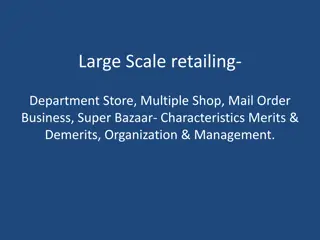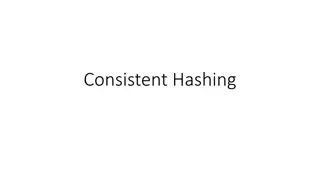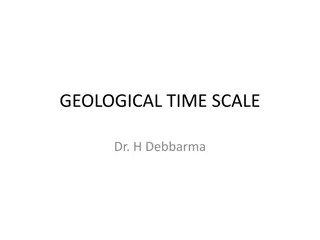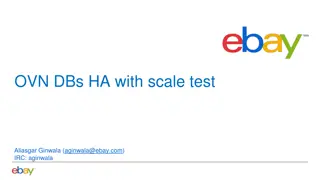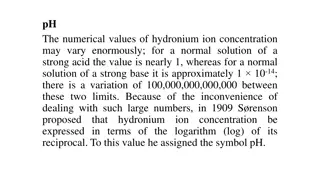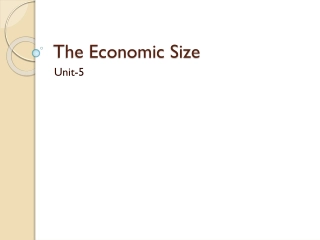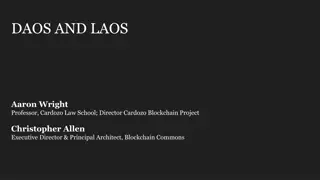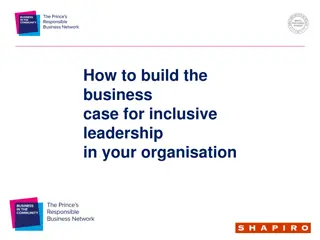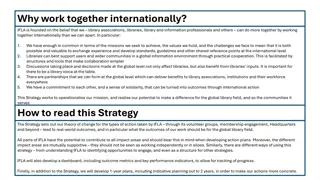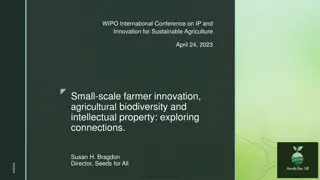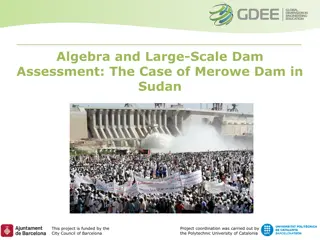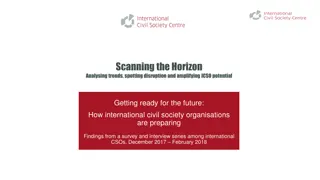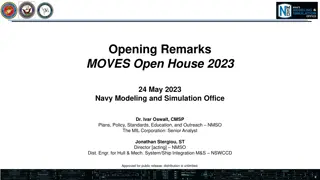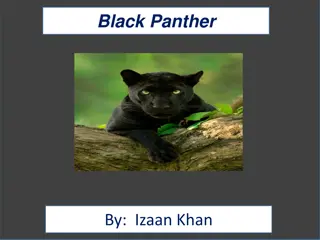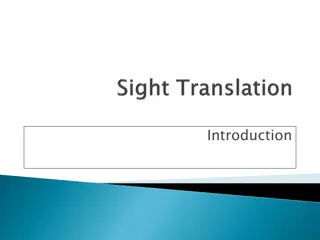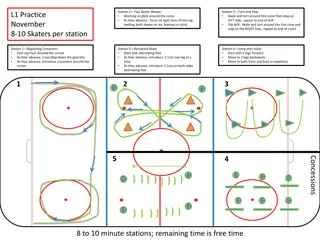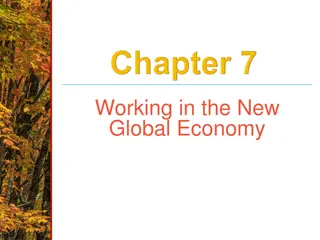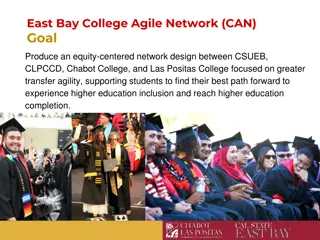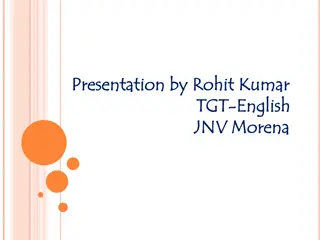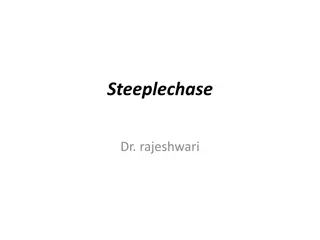Evolving Global Organizations for Agility and Scale
Explore the evolution of global organizations in the face of globalization, digital disruption, and shifting business models. Learn about designing structures for agility and scale, integrating global and local models, and navigating the complexities of the modern business landscape. The future lies in networked, digital organizations that blend agility with centered leadership to harness capabilities across boundaries. Discover strategic insights on operating models, lateral integrators, and the balance between global and local decision-making.
Download Presentation

Please find below an Image/Link to download the presentation.
The content on the website is provided AS IS for your information and personal use only. It may not be sold, licensed, or shared on other websites without obtaining consent from the author. Download presentation by click this link. If you encounter any issues during the download, it is possible that the publisher has removed the file from their server.
E N D
Presentation Transcript
http://orgdesigncomm.com/Resources/Header.png http://orgdesigncomm.com/Resources/Logo.png Designing Global Organizations for Agility and Scale Designing Global Organizations for Agility and Scale Greg Kesler and Amy Kates September 9, 2019 Greg Kesler and Amy Kates | www.kateskesler.com | +1.212.349.3522
Our topics for today 1| Match the operating model to the strategy 2| Design the structure for agility and scale 3| Build in the right lateral integrators Kates Kesler 2
1. Match the operating model to the strategy 3 Kates Kesler
Globalization has not been a straight line Global / Local Organization Models Seem to Continuously Evolve Increased protectionism http://www.shirtfactoryonline.com/links.htm Wave One: Local for local (largely decentralized) Economic cycles http://www.wiit.org/membership/Corporate%20Members.htm Fluctuating exchange rates Wave Two: Global (more centralized the world is flat ) Political and economic upheaval Wave Three: Shifting back and forth between global and local Emerging market infrastructure Kates Kesler 4
Shifting business models (and digital technology) create new design opportunities and challenges New Strategies & Business Models New Operating Models Digital Technology Omni-channel marketing and retail Solutions and platforms vs. single products and services New business incubation Vertical integration Customer / consumer engagement Ecommerce Digital product creation Running the business Organizations that enable agility and scale Global and local models co-exist More horizontal ways of working: collaborative organization Better cost structures Kates Kesler 5
Wave four should be different Wave Four: Networked, digital both agile and more center-led People can draw from assets and capabilities across boundaries. Work moves to where the capabilities and capacities are powered by digital. The center plays a linking role with the right blend of global and local decision-making about priorities and investment choices. Kates Kesler 6
How much integration/synergy do we need? Loosely Related Portfolio Fully Integrated Single Business Holding Co. or Conglomerate Closely Related Portfolio 1| 3| 4| 2| Single strategy guides all P&L units with minor variations. Complementary business portfolio and core strategies with synergies. Diverse, relatively autonomous businesses set strategies, with limited synergies across units. Structuring cheap finance, buying and selling separate assets. Strategy & Org Design Strategy and execution oversight comes from organizational center. All process and practices are common. Single culture. Business units drive strategy and varying degrees of execution, often with shared resources (in a matrix). Seeks benefits of scale in core technologies, product and commercial platforms, and/or back end operations. Business units drive nearly full execution of results with limited matrix Cross-BU scale is limited (e.g. government relations, technology transfer, back- end shared services). Some effort to harmonize culture. Focused on appointing leaders. Business units return financials to parent. No common processes. Multiple cultures. Governance Drives functional policy, staffing and standards to build a consistent global function presence across the company; Functional costs managed centrally. Orchestrates and owns a common strategic agenda and most processes. Collaborates closely with divisions to support execution. Manages company-wide talent process and shared services. Influences functional cost structure. Builds skills, tools, and talent practices necessary to strengthen a few functional capabilities. Priorities are guided mostly in divisions. May be a few selective shared services. Costs managed primarily within the business units. Limited company-wide policies and practices mostly focused on risk and fiduciary matters. Role of the Center Microsoft P&G PepsiCo Apple Heineken Coca-Cola Siemens Deere & Co. Medtronic Aditya Birla Group Unilever United Technologies Berkshire Hathaway Virgin Group Company Examples 1 2 3 4 5 6 7 8 Kates Kesler 7
2. Design the structure for agility and scale 8 Kates Kesler
Agility vs. leverage tension is at the center of every design choice Local, Autonomous, Separate Local, Autonomous, Separate Global, Scaled, Integrated Global, Scaled, Integrated Locally responsive to differences Focus by customer, region, product line Vertical approach to business units Clear accountability forP&Ls Fewer, bigger bets Directed from the center where it makes sense Global reach and network Shared resources and services Differentiated Adapt to market variations Business unit speed General manager accountability Integrated Adapt to new enterprise priorities Enterprise speed, portfolio shifts Harmonized, consolidated Duplicate resources P&L complexity High cost, lower RoA Bureaucratic Distance from customer Less accountability Kates Kesler 9
The structural building blocks of global organizations are similar All global organizations with closely related portfolios are made up of three fundamental components Regional Commercial Units Global Business Units Global Functions Kates Kesler 10
An organization model shows the relationship of components Consolidate Consolidate Differentiate Front Back Middle Organized to reflect market segments, regional differences, and key accounts Pushes innovation and manages work for efficiency, commonality, scale, and leverage across products Provides business leadership and is organized by category, brand, or product Bring best technology & new solutions Bring voice of customer & market Set differentiated strategies Product, Category, Brand Supply Chain Customer Management Business Unit A Business Unit B Technology R&D Sales Regions Business Unit C Enabling Functions (HR, Finance, IT, Legal, Communications, etc.) Kates Kesler 11
Differentiated middle with shared front and back Differentiate Consolidate Consolidate Cloud Product Areas Customers and Partners One common platform that all products are built on Products are no longer stand alone business units Regions, domains, B2B key accounts, consumers, partners Software as a service Infrastructure as a service Sales and Delivery Markets Office 365 Windows Domains Cloud XBox Partners Etc. Enabling Functions (HR, Finance, IT, Legal, Communications, etc.) Kates Kesler 12
Differentiated middle and back with shared front Med Device Co. Differentiate Consolidate Market Access and Delivery Organized to configure solutions within markets Product Innovation Business Leadership Pushes innovation and manages work for efficiency, commonality, scale, and leverage within products Provides full lifecycle management across a set of differentiated products Bring best technology & new solutions Manage fully loaded business units Bring voice of customer & market Devices, Hardware, Robotics Region Buyer/Payer Marketing Engineering, Supply Chain, Operations, Product Marketing Customer Marketing Practice Marketing Disposables and Supplies Countries Engineering, Supply Chain, Operations, Product Marketing Software and Services Key Accounts Engineering, Supply Chain, Operations, Product Marketing Enabling Functions (HR, Finance, IT, Legal, Communications, etc.) Kates Kesler 13
Differentiated front and middle with shared back Differentiate Consolidate R&D and Technology Four Sectors Front Differentiation across very diverse, competitive segments, including local for local products. Some shared resources, some aligned directly with business units. Heavily leveraged R&D and shared technologies Business Groups Voice of the Market Innovation & Supply Business Development, Marketing, Sales, and Operations Healthcare R&D/CTO (labs in 36 countries) Business Development, Marketing, Sales, and Operations Consumer Electronics & Transportation Business Development, Marketing, Sales, and Operations Manufacturing & Supply Chain Safety & Industrial Business Development, Marketing, Sales, and Operations Enabling Functions (HR, Finance, Business Transformation/IT, Legal Affairs, Corporate Affairs) Kates Kesler 14
Take-away A quick thought guide: Consolidate where scale gives advantage cost, expertise, global reach, platforms, technology investments Differentiate where being local gives advantage product innovation, customer knowledge, go-to-market relevance The logic can be applied as you design each component Remember, start with the organization model, not the organization chart. Many leadership team structures can support the same organization model! Kates Kesler 15
3. Build in the right lateral integrators 16 Kates Kesler
Structure is just one lever activation depends upon well designed networks led by the center Global Center-Led Centralized Single strategy, common process and tools, clear decision guard rails, empowered teams = freedom within a framework. Policy, controls, centralized reporting structures. Fiduciary controls. Integration High Control, Low Integration De-Centralized Bureaucracy heavy. High autonomy of BUs with little functional or central guidance and little synergy expected. Local Low Control High Kates Kesler 17
Example: How the center creates a community with shared priorities across a global network A new product idea starts in China, based on a center-led brand objective or trend. The center identifies that the Europeans would like to serve as test markets for the program will run tests. US-based team members pick up product and adapt to the North American market. Work moves to where the resources and talent are. Kates Kesler 18
Digital work presents a challenge for most companies Digital is not just one function each part has to be separated for agility while keeping the parts connected for a single customer experience. Digital commerce Digital product Digital brand Digital technology Where to Play Personalized services on the go Exceptional apps integrated with physical product A single platform across key markets Consistent brand interactions across physical and digital sales channels How to Win Mobile at the center of everything Kates Kesler 19
Each digital domain is hosted in the core organization structure Front Back Middle Provides business and product/ service leadership, organized by category, brand, or product. Organized to reflect market segments, regional differences, and key accounts. Pushes innovation and manages work for efficiency, commonality, scale, and leverage across products. Bring best technology & new solutions Bring voice of customer & market Set differentiated strategies Global Category Teams Commercial (Wholesale Regions and Retail) Technology Digital brand Digital Tech Backbone Digital commerce Digital product Kates Kesler 20
The design solution is to connect digital through a center-led network to provide the right mix of leverage and agility Europe Brick & Mortar Stores China Commercial Teams How do we resolve omni- channel conflicts and create a seamless shopping experience? Americas E-Commerce Brand Mktg. Digital Brand (Consumer Engagement) Brand Teams Center (e.g., Chief Digital Officer) How do we drive a single set of brand messages? Tech Community How do we maintain a single architecture? Product Engines Digital Product (Apps) Enterprise IT Technology Backbone Product Teams How do we assure a seamless experience across physical and digital product? Kates Kesler 21
The Star Model always ensures a holistic approach for building capabilities, such as digital How does digital fit into our business strategy? Strategy What talent profiles will thrive in center roles? Operating unit roles? Where will we play and how will we win? What will we buy and what will we build and own? Capabilities How do we best grow needed skills? What roles are needed in the center and in the operating units? People Practices Structure What decision authority will they have? What conversations need to be designed across the network? Governance and alignment Best practice sharing Innovation Metrics/ Rewards Process What does success look like? How can we best incent collaboration? Kates Kesler 22
Take-away: How to wire the network into a formal business construct Business objectives tightly aligned around a common strategy, with shared ownership for key metrics. Center role is elevated to report at senior levels with a seat at the executive table. A meeting cadence with standing agenda items heavily focused on integration working horizontally. Decision rights grant collaborative authority to the center, often including control over spending. Talent managed for the network with influence from the center. Kates Kesler 23
Design is the work of the business and HR 24 Kates Kesler
Building internal capability Leaders HR and OD 1. Think organization system, not org charts 1. Common set of frameworks, tools, and methods used across the enterprise 2. Involvement in activating the model 2. Consulting skills diagnostics, facilitation, and coaching 3. Make hard decisions 3. Connect talent, compensation, and change management to the organization design decisions 4. Patience to learn and adjust Kates Kesler 25
Kates Kesler LinkedIn Learning Organization Design and Change (17 videos, 55 min) KatesKesler.com YouTube Essential Topics (12 videos, 45 min) Kates Kesler 26
Resources Kates Kesler website (kateskesler.com) Fundamentals course through Cornell https://www.ilr.cornell.edu/programs/professional- programs/hr409/organizational-design-essential-hr-capability LinkedIn videos Linkedin.com/learning; search for Amy Kates or organization design YouTube Activation series https://www.youtube.com/playlist?list=PLzNDJ_6Xxuq4049o7GWdL02uFZ- ihPPdJ Organization Design Community (orgdesigncomm.com) Organization Design Forum (organizationdesignforum.org) Kates Kesler 27










